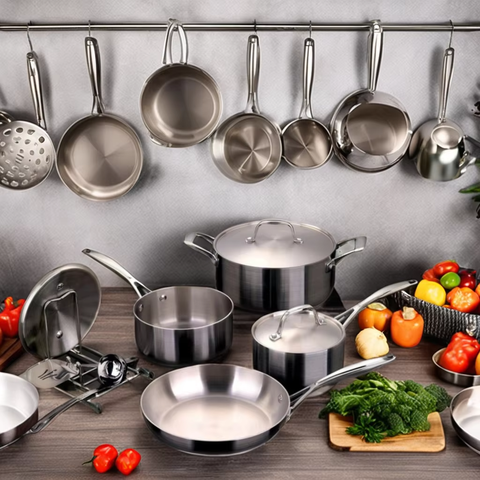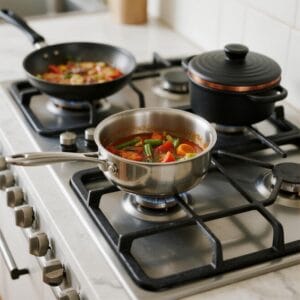Introduction: Triply circle material is highly regarded for its performance in high-heat cooking.
I’ve discovered that triply circle cookware stands out in high-heat cooking due to its unique construction. The combination of stainless steel and aluminum layers ensures excellent heat distribution and durability, making it a versatile option for a variety of high-temperature cooking techniques.
Triply circle cookware excels in high-heat cooking by combining even heat distribution, durability, and a non-reactive surface. The stainless steel outer layers provide strength and corrosion resistance, while the aluminum core ensures rapid and uniform heat conduction. This combination minimizes hot spots, making it ideal for searing, frying, and sautéing without compromising food quality.
Exploring the benefits of triply circle material, I see why it’s a top choice for professional chefs and home cooks alike. Its ability to maintain consistent heat, withstand extreme temperatures, and offer a non-reactive cooking surface makes it perfect for achieving superior results in high-heat recipes.
Cookware Materials for High-Heat Cooking
Different cookware materials have unique properties that determine their suitability for high-heat cooking.
- Cast Iron: Cast iron is well known for its excellent heat retention and durability. It can withstand extremely high temperatures, making it ideal for high-heat cooking, such as searing and frying. Cast iron heats up slowly but retains heat well, allowing it to maintain a consistent temperature.
- Stainless Steel: Stainless steel cookware is durable and non-reactive, making it safe for high-heat cooking. However, stainless steel on its own may not provide even heat distribution, which is why multi-layered designs, such as tri-ply cookware, are often preferred for improved heat conductivity.
- Carbon Steel: Carbon steel is similar to cast iron in many ways but is lighter and more responsive to heat changes. It can handle high temperatures well and is commonly used for tasks like stir-frying. However, it requires seasoning to maintain its non-stick properties.
- Copper: Copper has excellent heat conductivity and heats up quickly, which makes it effective for high-heat cooking. However, copper is often paired with a lining, such as stainless steel, to prevent reactions with food. The drawback is that it can be expensive and requires regular maintenance.
- Aluminum: Aluminum is a great conductor of heat but is not typically used alone for high-heat cooking due to its reactivity with acidic foods and potential to warp at very high temperatures. Hard-anodized aluminum, however, provides improved durability and can handle high temperatures more effectively.






Why Tri-Ply Cookware Is Ideal for High-Heat Cooking
Tri-ply cookware combines the best qualities of different materials to create a versatile, durable option for high-heat cooking.
- Material Composition: Tri-ply cookware is constructed with three bonded layers—an inner layer of stainless steel, a core layer of aluminum, and an outer layer of stainless steel. The stainless steel layers provide strength and non-reactive properties, while the aluminum core offers excellent heat conductivity.
- Heat Conductivity and Distribution: The aluminum core in tri-ply cookware allows for fast and even heat distribution, which is crucial for high-heat cooking. This ensures that food cooks consistently, reducing the likelihood of burning or undercooking.
- Durability: The combination of stainless steel and aluminum makes tri-ply cookware extremely durable and resistant to warping, even at high temperatures. This durability is essential for high-heat cooking techniques such as searing, browning, and frying.
- Non-Reactive Surface: The stainless steel surface is non-reactive, meaning that tri-ply cookware can be used to cook acidic foods without worrying about leaching harmful substances into the food, which is especially important when cooking at high temperatures.
Comparison of Cookware Materials for High-Heat Cooking
To determine which material is best for high-heat cooking, it’s helpful to compare the properties of different cookware materials.
- Cast Iron vs. Tri-Ply: Cast iron is excellent for heat retention but is heavy and can be less responsive to temperature changes. Tri-ply cookware, on the other hand, heats up faster and provides more even heat distribution, making it a more versatile choice for a variety of cooking methods.
- Carbon Steel vs. Tri-Ply: Carbon steel is lightweight and handles high heat well, but it requires seasoning to maintain its non-stick properties. Tri-ply cookware is easier to maintain, offers better heat conductivity, and provides a non-reactive cooking surface, making it more convenient for everyday use.
- Copper vs. Tri-Ply: Copper provides superior heat conductivity but is expensive and requires frequent maintenance. Tri-ply cookware offers similar benefits in terms of heat distribution without the need for constant upkeep, and it is more affordable.
- Aluminum vs. Tri-Ply: Aluminum heats quickly but can warp at high temperatures. Tri-ply cookware, with its stainless steel layers, offers greater durability and stability under high heat, making it better suited for high-heat cooking.
Advantages of Tri-Ply Cookware for High-Heat Cooking
- Versatility: Tri-ply cookware is compatible with all types of cooktops, including induction, gas, electric, and ceramic. This versatility means it can be used for a wide range of cooking methods, including those that require high heat.
- Quick Heating and Heat Retention: The aluminum core provides fast and even heating, while the stainless steel layers help retain heat, making it ideal for high-heat cooking techniques like searing and browning.
- Ease of Maintenance: Unlike cast iron or carbon steel, tri-ply cookware does not require seasoning, making it easier to maintain. Its stainless steel surface is also resistant to rust and corrosion, ensuring long-lasting performance.
- Energy Efficiency: The efficient heat transfer provided by the aluminum core means that tri-ply cookware heats up quickly, reducing the amount of time and energy required to reach high cooking temperatures.
Tri-Ply Circle Material Introduction
Tri-ply circle material is specifically designed for high-quality cookware that demands even heat distribution and durability.
- Construction Process: The tri-ply circle material is made by bonding three layers—an inner stainless steel layer, a core aluminum layer, and an outer stainless steel layer—under high temperature and pressure. This process creates a strong, uniform bond that enhances the performance of the cookware.
- Benefits of Tri-Ply Circle Material: The combination of stainless steel and aluminum ensures even heating, durability, and compatibility with all cooktop types, including induction. This makes tri-ply circle material a preferred choice for manufacturing high-quality cookware.
- Applications: Tri-ply circle material is used in various types of cookware, such as frying pans, saucepans, and stockpots, all of which benefit from its even heating and durability, making them suitable for high-heat cooking.
Conclusion
When it comes to high-heat cooking, I’ve learned that choosing the right cookware material is key to achieving consistent results and cooking safely. While materials like cast iron, carbon steel, copper, and aluminum each have their benefits, I find that tri-ply cookware truly stands out. Its multi-layer construction, combining stainless steel and an aluminum core, offers excellent heat conductivity, durability, and versatility. Whether I’m searing, browning, or working with high temperatures on gas, induction, or electric cooktops, tri-ply cookware delivers outstanding performance and energy efficiency. It’s become my go-to choice for both everyday meals and professional-level cooking.
Frequently Asked Questions (FAQs)
- Is tri-ply cookware suitable for high-heat cooking?
- Yes, tri-ply cookware is designed to handle high heat, making it ideal for searing, browning, and frying.
- How does tri-ply cookware compare to cast iron for high-heat cooking?
- Tri-ply cookware heats up faster and provides more even heat distribution compared to cast iron, which retains heat well but is slower to respond to temperature changes.
- Can tri-ply cookware be used on all cooktop types?
- Yes, tri-ply cookware is compatible with induction, gas, electric, and ceramic cooktops.
- Does tri-ply cookware require seasoning like cast iron or carbon steel?
- No, tri-ply cookware does not require seasoning. Its stainless steel surface is easy to maintain and non-reactive.
- What makes tri-ply cookware better for high-heat cooking than aluminum?
- Tri-ply cookware has a stainless steel exterior that provides durability and prevents warping, while the aluminum core ensures even heat distribution, making it more suitable for high-heat cooking than aluminum alone.
- Is copper better than tri-ply cookware for high-heat cooking?
- Copper offers excellent heat conductivity, but it requires regular maintenance and can be expensive. Tri-ply cookware provides similar heat distribution benefits without the need for frequent upkeep.
- Can tri-ply cookware handle oven temperatures?
- Yes, most tri-ply cookware is oven-safe and can handle high oven temperatures, making it versatile for various cooking methods.
- What are the benefits of the aluminum core in tri-ply cookware?
- The aluminum core provides fast and even heat distribution, which is essential for preventing hot spots and ensuring consistent cooking results.
- How does tri-ply cookware compare to carbon steel for high-heat cooking?
- Tri-ply cookware offers better heat distribution and does not require seasoning, making it easier to use and maintain compared to carbon steel.
- Is tri-ply cookware energy-efficient?
- Yes, the efficient heat transfer provided by the aluminum core makes tri-ply cookware energy-efficient, reducing the time and energy needed to reach high cooking temperatures.







2 Responses